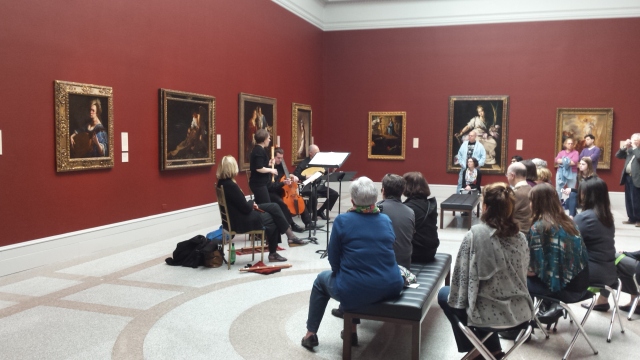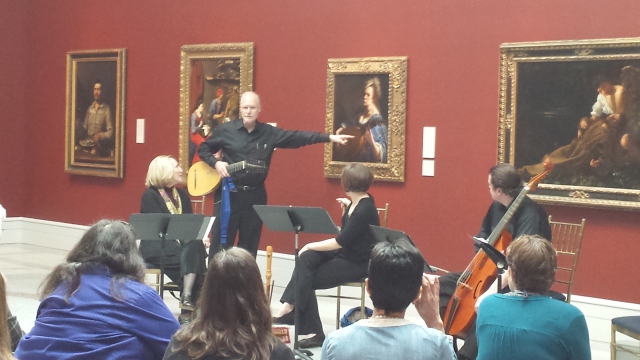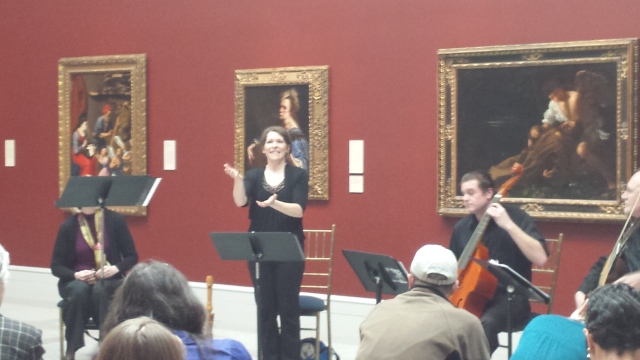A week ago today, several colleagues and I performed a lunchtime concert at the Wadsworth Atheneum in downtown Hartford.

In 2014, the Wadsworth purchased the Self-Portrait as a Lute Player (c.1615-17) by Artemisia Gentileschi. This was a significant purchase for the Wadsworth; not only is it the first work by the esteemed painter in a New England museum, but it is the first painting by a woman in the Wadsworth’s Baroque Italian art collection. The self-portrait can be seen below and on the left-hand side of the above picture; the paintings immediately to the right are by Michelangelo da Caravaggio and her father, Orazio Gentileschi (1563-1639).

Artemisia Gentileschi (1593–c.1656) studied from a young age with her father, who was a prominent painter in Rome and who later worked in the courts of Marie de Medici and Charles I of England. After 1600, Orazio began to paint in the style of Michelangelo Caravaggio, and so Artemisia’s early tutelage reflected his influence. She was the first female painter to be accepted as a member of the Accademia del Disegno in Florence, and it was there that she became acquainted with and worked for the younger Michelangelo Buonarotti (a great-nephew of the famous Michelangelo) and Cosimo II de Medici, Grand Duke of Tuscany, who might have commissioned this self-portrait. The record of the portrait in the Villa Medici inventory shows that it was originally a good bit larger, and was apparently trimmed later on for reasons unknown.
Artemisia is often held up as an early feminist model today, not only for her successes as a painter but also for a drastic personal event: a colleague of her father’s, Agostino Tassi, raped her when she was seventeen and under his tutelage. Believing that he would marry her, Artemisia apparently continued relations with him; when he reneged, she and her father pressed charges against him in court and won. During the trial, which lasted seven months and during which Artemisia was tortured by thumbscrews, it became known that not only had Tassi been accused of rape twice before, but he might have been involved in plots to kill his second wife and to steal some of Orazio’s paintings. He was convicted in 1612 and sentenced to two years in prison, but the verdict was annulled and he was free as of 1613.* Artemisia was hurriedly married to Pierantonio Stiattesi, a lesser-known artist, and left with him for his native Florence, but due to his massive debt, she left him and returned to Rome on her own. While we have a good deal of information on the remainder of her life as a woman and as a painter, we have precious little idea as to how she died; she last appears in the historical record accepting commissions in 1654, and scholars have speculated that she might have died in a resurgence of the plague in Naples in 1656.
As the portrait is of Artemisia playing the lute, I thought it would be a nice idea to welcome the painting into its new home by performing a concert featuring lute works, works by female composers, and music that Artemisia herself might have known. In addition, my colleagues and I provided spoken program notes about the music, composers, and instruments, and lutenist Eric Hansen spoke at length about the particular lute depicted in the portrait.

Our first set was comprised of Italian music c. 1600, music that Artemisia herself might have known or that had interesting connections to her life and times. We began with a set of Sinfonias by Jewish composer Salamone Rossi (c.1570-1630), which worked nicely for our combination of bass viola da gamba, lute, Renaissance flute, and recorder. Like Artemisia, Rossi (and his famous opera-singing sister, known as Madame Europa) might have died in the plague, though several decades before Artemisia. We then introduced female composer and lutenist Maddalena Casulana (c.1544–1590), who achieved professional success similar to Artemisia in that she was the first female composer to have her music published in print. We performed her madrigal “Io d’odorate” as a three-voice instrumental work.
 We closed off the set with Giulio Caccini’s monody “Amarilli, mia bella,” performed on recorder with lute & gamba basso continuo, followed by a set of solo recorder divisions on the tune by Jacob van Eyck (c.1590–1657). Caccini (1551-1618) is somewhat a counterpart to Artemisia’s father, Orazio, as his daughter Francesca (1587–after 1641) became a famous composer, singer, and lutenist in her own right; she is considered to be the first female composer of opera.
We closed off the set with Giulio Caccini’s monody “Amarilli, mia bella,” performed on recorder with lute & gamba basso continuo, followed by a set of solo recorder divisions on the tune by Jacob van Eyck (c.1590–1657). Caccini (1551-1618) is somewhat a counterpart to Artemisia’s father, Orazio, as his daughter Francesca (1587–after 1641) became a famous composer, singer, and lutenist in her own right; she is considered to be the first female composer of opera.
Our second and third sets were a bit shorter. The second featured a set of Italian dances for Renaissance flute, lute, and gamba associated with the dancing tutorials of Cesare Negri (c.1535-c.1605) and Fabritio Caroso (1526/35-1605/20). Both gentlemen were dancing masters, Negri having republished his Nuove Inventioni di Balli in 1604 and Caroso his Il Ballarino in 1581. At least in the latter case, many of the dances are dedicated to noblewomen, and as a woman of a particular social status, it is likely that Artemisia had herself received some instruction in the art of dance.

The third set was a short collection of solos for the six-course lute. This set of English pieces (My Lord Willoughby His Welcome Home, Kemp’s Jig), was likely unknown to Artemisia but offered an opportunity for Eric Hansen to describe the construction of the lute in Artemisia’s portrait and to showcase the lute in a solo setting.

Three rather disjunct pieces concluded the program. The first was the Canzon Prima by Giovanni Gabrieli (c.1554/57-1612), performed by Renaissance flute, archlute, and gamba. Gabrieli is one of the masters of the Venetian school, having spent the majority of his life associated with various musical institutions in Venice; Artemisia went to Venice herself for a time, though after Gabrieli’s death. The second piece greatly postdated Artemisia’s death but offered Dee Hansen (left) an opportunity to highlight the Baroque flute on an Andante movement of a sonata by French composer Anna Bon (c.1739-?).
For a rousing conclusion, we decided to finish with Diego Ortiz’s Recercada Segunda. Italy and Spain maintained close political and religious connections during the sixteenth and seventeenth century, so Artemisia might well have been familiar with Spanish-influenced musical traditions. The Ortiz piece allowed gambist Neal Humphreys a chance to shine, and lastly, it allowed us to make reference to another musical painting: on the far wall of the gallery is Spanish painter Francisco Ribalta’s “The Ecstasy of Saint Francis of Assisi: The Vision of the Musical Angel” (c.1625), which features an angel playing a lute.

The concert was a rousing success. In addition to having a crowd of about twenty or thirty who came specifically for the concert, we gained wandering visitors to the museum who were passing through the gallery and stayed for some music. Because of the openness of the gallery and the fact that it sits not far off the main hall, visitors walking around several floors of the museum could hear the music as they explored other areas, and we heard from some of them after the concert that it added a wonderful element to their experience. The questions afterward were quite perceptive; several people (including the museum curators) mentioned how much they enjoyed Eric Hansen’s description of the lute in the painting, while others asked after specific pieces or composers. On the whole, the audience appeared to have truly enjoyed themselves, and the performers did as well. The space was lively and resonant, and was the perfect size and acoustic space for our small group of instruments. It was a wonderful occasion to partner with a local cultural institution not only to provide a musical experience but to forge specific historic-cultural connections between the arts in a publicly accessible space. Adding to the significance of the event was of course the ability to showcase major female contributors to the arts, and to have the concert occur (quite serendipitously) during the Women Composers’ Festival of Hartford was a particular perk. I for one hope that we have the opportunity to work again with the Wadsworth Atheneum, which was a most gracious host and partner, and I look forward to exploring ways to work with other local cultural institutions in similarly accessible ways.
— Karen Cook
March 18, 2016
*For more information on this trial, see Elizabeth Cohen, “The Trials of Artemisia Gentileschi: A Rape as History,” in The Sixteenth Century Journal (2000): 47–75.
